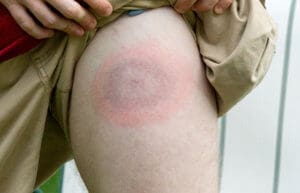The Centers for Disease Control (CDC) lists sixteen different diseases transmitted by ticks in the United States, including Lyme disease, Babesiosis, Anaplasmosis, and Ehrlichiosis. Since 2004, confirmed cases of tick-borne disease in the U.S. has doubled, with an estimated 476,000 people diagnosed with Lyme disease annually. In fact, Lyme disease had become the most pervasive vector-borne disease in the Northern Hemisphere. However, despite the growing number of cases, tick-borne diseases are often difficult to diagnose.
 Four common reasons tick-borne diseases are hard to diagnose:
Four common reasons tick-borne diseases are hard to diagnose:
- The symptoms of tick-borne disease often mimic the flu- Lyme disease can actually be one of the easier diseases to diagnose because, in addition to flu-like symptoms, it causes an erythema migrans (EM) rash in 70-80% of patients, which resembles a “bull’s eye”. However, other diseases such as ehrlichiosis and anaplasmosis do not come with a visible rash but instead have symptoms like fever, muscle aches, and headache that begin about two weeks after a bite.
- Symptoms may show up long after the tick bite- Some symptoms may present themselves within three days, while others may take 30 days or more to show up. In some cases, the symptoms begin so late that the person may have forgotten about possible exposure to ticks or were unaware they had suffered a tick bite.
- Diagnostic tests are not reliable- Laboratory tests for tick-borne diseases are notoriously inaccurate. False negatives are common, especially during the early stages of the disease. According to Gerrit Mueller, director of project management for Gold Standard Diagnostics in Davis, California, “The problem with Lyme disease is that the bacteria hides really well.” New tests are continuously being developed to achieve better accuracy.
- A person may have multiple diseases from a single tick bite- Ticks can carry more than one disease; once bitten, a person is subjected to all of them. Since symptoms of tick-borne diseases can be similar, a patient may be treated for the most common one while a secondary infection is left untreated. For example, a patient with Lyme disease may be given doxycycline as an effective treatment but worsen because of an undetected babesiosis condition that requires different medication.
What should you do if a tick has bitten you?
- Wear medical-type gloves and use tweezers to remove the tick. Grasp the tick as close to your skin as you can. Pull the tick straight out–do not twist or turn it.
- Kill the tick by placing it in alcohol and then put the tick in a sealed plastic bag in the freezer. Date the bag and note the location you think the tick came from. By doing so, you can bring the tick to your health care professional later for diagnostic testing if you begin to show symptoms of a tick-borne disease. It’s important to note that even if you show signs, you may have gotten the disease from a different tick bite, making testing the tick not 100% reliable.
- Wash the site of the bite well with soap and water. Apply rubbing alcohol to sanitize the area.
- Watch for symptoms over the next 30 days: rash, fever, fatigue, headache, muscle pain, or joint swelling and pain. If symptoms appear, visit your health care professional for diagnosis.
Learn more about how to protect yourself from tick-borne diseases at JCVCD.org.
The Jackson County Vector Control District (JCVCD) is your resource for education and solutions to reduce the risk to you, your family, and your neighbors related to disease-transmitting pests. Vectors are living organisms that can transmit diseases between humans or from other animals to humans. Oregon’s most common vectors include mosquitoes, flies, rats, and ticks.

 Four common reasons tick-borne diseases are hard to diagnose:
Four common reasons tick-borne diseases are hard to diagnose: